Casino game craps rules
This is a bet that the shooter will throw a 7 or 11 on the come out roll or, alternatively, that the shooter will make the point. This bet is similar to the don't pass bet, but need not be made on the come out roll.
Craps game rules
Craps is a favorite casino game for many players. It is fast, exciting and can even get a little wild at times. It appears to be complicated at first but it actuality is very simple. On the first roll (the come out roll), the shooter is trying to establish a point with one of the following numbers: 4, 5, 6, 8, 9, or 10. If the shooter rolls a 7 or 11 the wager is paid off at even money. If the shooter rolls a 2, 3, or 12 then the wager is lost. If the shooter rolls a point number, then it progresses to the next stage where the shooter has to roll the same number again before rolling a 7.
Types of bets:
Online craps is surprisingly true to the real deal. All the bets are available, and the odds are on point.
There are several types of bets which can be placed on a craps table.
The pass bet
This is a bet that the shooter will throw a 7 or 11 on the come out roll or, alternatively, that the shooter will make the point.
The don't pass bet
This is the opposite of the pass bet. This bet is placed against the shooter and wins if craps (2, 3 or 12) is thrown on the come out roll or if the shooter fails to make the point. If a 12 is thrown, the bet ties.
The come bet
This bet is similar to the pass bet but need not be made on the come out roll. (it is mainly available to allow players newly joining the table to take part in the action immediately, instead of having to wait for the shooter to make or miss the point!)
The don't come bet
This bet is similar to the don't pass bet, but need not be made on the come out roll.
Odds bet
This is an additional bet made on a pass, don't pass, come or don't come bet that has already been placed. Odds bets can only be made once the point has been established. The advantage of an odds bet is that it is paid out at the correct odds.
Win bet
This bet can be made on the following numbers: 4, 5, 6, 8, 9, 10. It is a bet that the relevant number will be thrown before a 7.
Lose bet
This bet can be made on the following numbers: 4, 5, 6, 8, 9, 10. It is a bet that a seven will be thrown before the relevant number.
Field bet
This is a bet on the outcome of the next throw. It pays even money if a 3, 4, 9, 10 or 11 is thrown and 2-1 if a 2 or 12 is thrown.
Hardways bet
This bet can be made on 4, 6, 8 or 10. It is a bet that the relevant number will be thrown in its double form before a 7 and before that number is thrown in any other combination.
Any seven: pays 5 for 1 (4 to 1) if a 7 is made in the next throw.
Any craps: pays 8 for 1 (4 to 1) if a 2, 3 or 12 is made in the next throw.
Craps two: pays 30 to 1 if a 2 is made in the next throw.
Craps twelve: pays 30 to 1 if a 12 is made in the next throw.
Craps three: pays 15 to 1 if a 3 is made in the next throw.
This is a single roll bet on any craps (2, 3 or 12) and 11. Odds are paid out accordingly.
Game rules:
Play craps at one of the internet's leading casino sites.
Advertisement
New casino sites to play real money
| ||||
| number | combination | ways to roll |
|---|---|---|
| 2 | 1-1 | one |
| 3 | 1-2, 2-1 | two |
| 4 | 1-3, 3-1, 2-2 | three |
| 5 | 1-4, 4-1, 2-3, 3-2 | four |
| 6 | 1-5, 5-1, 2-4, 4-2, 3-3 | five |
| 7 | 1-6, 6-1, 2-5, 5-2, 3-4, 4-3 | six |
| 8 | 2-6, 6-2, 3-5, 5-3, 4-4 | five |
| 9 | 3-6, 6-3, 4-5, 5-4 | four |
| 10 | 4-6, 6-4, 5-5 | three |
| 11 | 5-6, 6-5 | two |
| 12 | 6-6 | one |
Names of dice rolls in craps
Game session preparations:
Set your budget – as a general rule, you need enough for 50 bets when playing craps and other table games.
Choose your table – all will have a minimum and maximum amount you can place on all different bets, choose one where each of your favorites is no more than one-fiftieth of your budget. I.E. If you have a bankroll of $/€/£200, you should be looking at betting no more than $/€/£4 per time
Find a space at the table – unlike many casino games, players always stand and do not have a specific area where they place bets – there are many different types of bets that all players can use. This is irrelevant when playing online.
Decide how much you would like to change up and play with – you will be given chips, the sizes of which depend on how much you change up and the limits of the tables.
Game progression
To begin, the shooter (one of the players) needs to bet at least the table minimum on either the pass line or the don’t pass line
The game is played in rounds, with the right to roll the dice by each player moving clockwise around the craps table at the end of each round. A player may choose not to roll but can continue to bet.
Once all players have made their desired bets, the round begins. Each round has two phases: come out and point. To start a round, the shooter makes one or more come out rolls.
Payouts are sometimes made after each roll, and sometimes made after several rolls; see the individual bet descriptions for details.
Craps table layout

We will delve more into the table layout features below in the placing bets in craps section. On the craps table there are two dealers, a stickman, and a boxman.
The stickman uses a long flexible stick to push the dice around the craps table, gathering the dice after rolls and pushing them to the player.
The boxman is the person in charge of the game and has final decision-making authority.
The dealers cash chips and ensure that bets are placed on the table correctly.
Placing bets in craps
Out of 990 decisions at the craps table, you can expect to lose 14 decisions more than you win.
As with any casino game, there will invariably be swings, both large and small, either way when it comes to winning or losing. In the relatively short time you will be playing, there will be fluctuations in this house edge, so at times things will be going in your favor.
You can place craps bets at any time, the best time to start doing this is when a new shooter starts. The first thing he needs to do is establish a point.
If a shooter rolls a 4, 5, 6, 8, 9 or 10 on his/her first roll, all other bets below can be made.
If a 2, 3 or 12 are rolled, all players will win they are come out bets and the shooter will continue rolling to establish a new point.
If a 7 or 11 are rolled, all players will lose their come out bets and a new shooter will be designated.
Pass line/don’t pass line
When it is your turn to throw the craps dice, you must determine whether to bet the pass line or the don’t pass line. Most shooters, as well as most of the other craps players at the table, will bet the pass line, as it is the basic bet in craps.

The pass line bet is an even-money bet that wins if you either roll a total of 7 or 11 on the come-out roll or if you throw a 4, 5, 6, 8, 9 or 10 on the come-out roll and repeat that number before you roll a 7. The pass line bet loses if the come-out roll is a 2, 3, or 12 (known as “craps”) or when a 7 is rolled before the established point number is repeated.
A pass line bet can be made at any time during a shooter’s roll, even after he has established a point. However, a bet placed on the pass line after a point has been established is a very poor bet, since you have missed the opportunity to win on the come-out roll when the shooter throws a 7 or an 11. The only way you can now win is if the shooter repeats his point before he sevens-out.

Come bets
A come bet is identical to a pass line bet, with one exception: A come bet may be made on every throw of the dice once the shooter has established a point. A come bet is made by placing the number of chips you wish to wager in the designated come area of the craps layout.

Once you place a come bet, the very next roll of the dice becomes the come-out roll for that bet. Therefore, if the shooter rolls a 7, you will win even though pass line betters will lose. If an 11 is rolled, you will win while the line bets will not be affected. However, should one of the craps numbers come up (2, 3 or 12) you will lose, but the line bets will be unaffected.
If the shooter throws one of the box numbers on the first roll of the dice after you’ve made a come bet, this number becomes an established point for your come bet. To win this bet, your come point must be repeated before a 7 is rolled.
Once a point has been established for your come bet, the dealer will move the chips you have bet to the corresponding numbered box on the craps layout to await a decision for that point. When you win a come bet, the dealer will pay you off by placing your original bet, along with your winnings, in the come section of the layout. If you do not immediately retrieve your chips, they will be in action on the next roll of the dice as a new come bet (this is collected for you automatically when playing online).
The don’t-pass line bet
We know that a pass line bet is simply a wager that the shooter will win. But you also can bet that the shooter will fail to make a pass and thus lose.

The don’t pass line bet wins when the shooter throws a craps of 2 or 3, but not 12, on the come-out roll, or when he rolls a 7 before repeating his established point number. This bet loses when the come-out roll is a 7 or 11, or when the shooter repeats his point number before rolling a 7.
The don’t pass line bet is the exact opposite of a pass line with one exception: although a roll of 12 on the come out loses for pass line betters, it is not a winning number for don’t pass betters. It is a stand-off and neither wins nor loses. This is because if don’t pass betters were permitted to win in this situation, they would have an advantage over the house. So by barring (disallowing) the number 12 on the come-out roll, the casinos retain a small edge. Some casinos bar the number 2, but the effect is exactly the same.
Unlike a pass line bet, a don’t pass bet can be removed after a point number has been established on the come-out roll. Once a point is established you have an advantage over the house, thus the casino has no objections to your taking down the bet. Of course, you should never do this. After going up against an 8 to 3 house edge on the come-out roll, you will have an overall average advantage of 18.8% after a point has been established.
Laying the odds
When the shooter establishes a point number on the come-out roll, players who have made don’t pass line bets are permitted to lay the odds. In the same way, don’t come bets are the exact opposite of come bets (with the exception of a 12 is rolled on the come bet), the laying the odds bet is the exact opposite of an odds bet (which no exceptions).
Correct payoffs for lay odds bets are as follows:

Don’t come bets
Don’t come bets can be placed on every throw of the dice after a point has been established. After you have placed a don’t come bet, the very next throw of the dice becomes the come-out roll for that bet. If the shooter rolls a craps number of 2 or 3, you will win while don’t pass line betters will not be affected. If a 7 is rolled, you will lose and bets on the don’t pass will win. You also will lose if an 11 is thrown, although this number will not have a bearing on don’t pass bets. A roll of 12 is a stand-off.

Place bets on 6 and 8
A place bet can be made on any of the point numbers (4,5,6,8,9,10) at any time during a game and is simply a bet that one of these numbers will be rolled before the shooter throws a 7. You cannot take the odds on place bets.
Place bets on the 6 and 8 are paid off at 7-to-6 on correct odds of 6-to-5, which gives the casino an advantage of 1.51% on these numbers. To ensure that you receive the full 7-to-6 payoff on the 6 and 8, you must make your bet in multiples of six, such as $6, $12, $18, and so forth (this isn’t the case when playing online)
Place bets on the 5 and 9 carry a house advantage of 4%, and place bets on 4 and 10 carry a house advantage of 6.6%.
Field bets
This is a bet on the next number to be rolled. There are seven numbers inside the field area that if rolled, will result in a win. The numbers are 2, 3, 4, 9, 10, 11 and 12. If you make a wager in the field and any of the above numbers show on the next roll you will win. In many casinos and some online sites, you win double or even treble your bet if a 2 or a 12 are rolled.

Proposition bets
These bets can be made at any time and, they are all one roll bets.

Any craps: wins if a 2, 3 or 12 is thrown. Payoff 7:1
Any seven: wins if a 7 is rolled. Payoff 4:1
Eleven: wins if a 11 is thrown. Payoff 15:1
Ace duece: wins if a 3 is rolled. Payoff 15:1
Horn bet
: it acts as the bets on 2, 3, 11 and 12 all at once. Wins if one of these numbers is rolled. The payoff is determined according to the number rolled. The other three bets are lost.

Hardways bets
This is a bet on a specific double coming out on the next roll. For example, if a player is putting money on the hard 6 the player is betting that the shooter will roll a 3,3. You can only bet on 2:2, 3:3, 4:4 or 5:5, and you are betting on a specific double to appear and not covering all of them.

Best craps bets
Taking the odds
When the shooter establishes a point on the come-out roll, any player who has made a pass line bet is allowed to “take the odds.” A single odds bet is an additional bet, up to the amount of your original bet, that the point number will be repeated before a 7 is rolled.
*important* the “odds bet” is the best one you can make in the game of craps because the house has no built-in advantage.
The odds bet not only hasn’t any house edge associated with it, but also has no official designated space on the craps table. Therefore, to take the odds, you must place the appropriate amount of chips behind your pass line bet in the open area of the craps layout (this is also the same when playing online).
The correct payoff for odds bets varies from point number to point number, depending on the odds of a 7 being rolled before a particular point is repeated. Correct odds payoffs are as follows:
Craps rules: basic and advanced game strategies
Craps rules refer to the different rules, customs, and strategies applying to the popular casino game of craps.
What is craps?
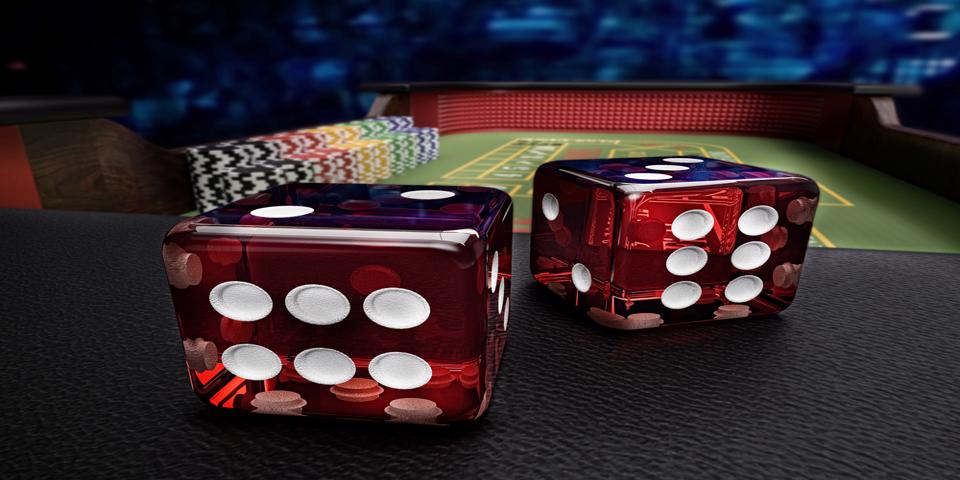
Follow the shouting, hooting, and hollering in any casino and you won’t find yourself at a poker or blackjack table. That’s where players go to practice their imitation of a house cat, betting on cards with blank expressions and hardly a peep. Instead, you will probably find yourself at the craps table.
The craps table is a volcano of excitement. Players shout at each other, at the dealers, and at lady luck, exploding in cheers of excitement over a favorable roll, dissolving into cries of despair over a losing one.
Craps is a casino dice game dating back to early-1800s new orleans. However, its origins in europe may run even deeper.
At its heart, craps is a very simple game. A player (the “shooter”) rolls two dice (“shoots craps”) and the shooter and other players bet on the outcome.
Around these basic principles, a whole universe of rules, customs, specialty terms, and forms of “side action” have evolved.
Certain dice rolls are always winners for the shooter, while other rolls are always losers. Side wagers can be staked on whether or not the shooter wins.
A brief history of craps
Thrill-seeking louisiana heir bernard xavier philippe de marigny de mandeville returned from a trip abroad in 1807 to his colonial home, where his family had become wealthy in plantation agriculture. While overseas, he had developed a taste for a dice game called hazard, the roots of which may extend back to the crusades.
Hazard players select a winning dice outcome of any number between 5 and 9 before betting. De marigny discovered that 7 was the most likely winning outcome and taught a version to his peers where only 7 was the winning roll.
His peers rewarded his innovation by roundly rejecting the game, considering it boorish. Indignant, de marigny sought out other “boors” to share his dice-throwing passion.
The game caught on among new orleans’ lower classes. They called it “shooting crabs,” which eventually morphed into “shooting craps.” the name later acquired a scatological twist when “using the crapper” entered the lexicon thanks to the famous toilet manufacturer thomas crapper. Subsequently, losing dice rolls of 2 or 3 came to be known as “craps.”
Today, craps is played informally among friends who bet and play against each other. Especially popular in its origin city of new orleans, “street craps” is popular because all you need to play is a pair of dice.
It’s also played at low-end, mid-range, and high-end casinos across the world on purpose-built tables, with players betting against the house. Online casinos also offer craps.
What are the basic rules of craps?

The craps table
Craps need not be played on an official craps table. However, casino craps uses a specialized table to keep the wagers organized.
The craps table is divided into side sections, managed by dealers, and a center section, manned by the stickman. The side sections contain areas for each type of bet, including pass line, don’t pass line, come, don’t come, field, and big-6/big-8 wagers. Players can lay chips down in the appropriate section to indicate the nature of their bet.
The table is deep-set and surrounded by high bumpers lined with pyramidal rubber, which the dice bounce off when thrown.
The players
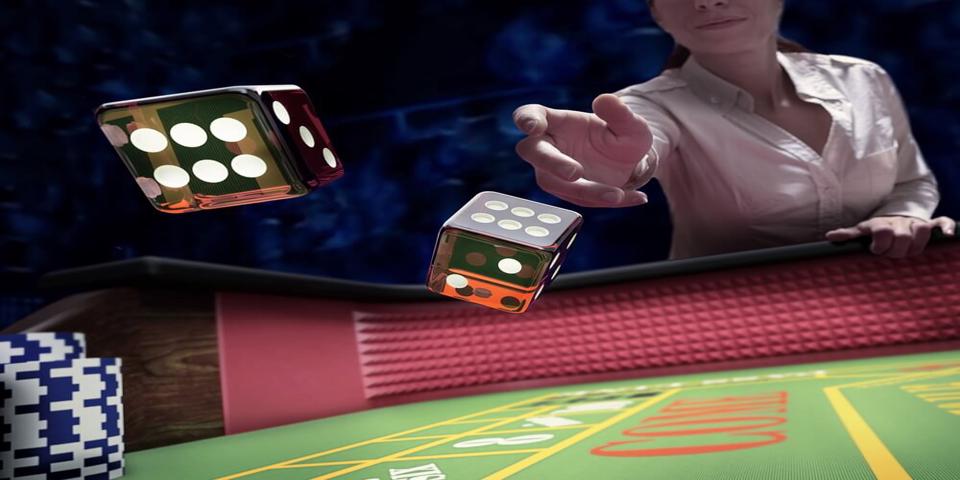
Players encircle the table. Shooting turns pass clockwise (to the left) of each player.
In addition to the shooters, the house fields a team of four:
Dealers
At least two dealers–who are sometimes called the “dealer on base”–man the table on each side, keeping track of bets, paying out winnings, placing pucks on the “point” marker when the point has been established, and placing certain bets for you (e.G. Come or don’t come bets).
Stickman
Also called “stickwoman,” “stickperson,” or “dealer on the stick,” the stickman is the keeper of the dice used in the game. (S)he uses a long stick–sometimes called a “whip” or “mop”–to handle them.
Boxman
At least one “boxman” (or “boxwoman” or “boxperson”) monitors the whole game, settling disputes and visually confirming fair play on the part of both players and dealers.
The dice

Casinos maintain tight control of their craps dice, often right from the factory to the table, as they are susceptible to tampering by cheaters.
Once in play, casinos maintain equally tight control, constantly inspecting the dice for damage. As in all casino games, craps yields a predictable edge to the house when you factor in all shoots. Damaged dice produce unpredictable outcomes, and unlike the players, casinos are not betting their financial fortunes on chance.
The stickman inspects the dice after each use, the dice usually being retired after eight hours of gameplay.
Rules for dice handling

Certain rules also govern the way dice are handled at a casino craps table. The stickman presents a selection of dice–usually five–from which the player selects two. The stickman then retrieves the unselected dice with the stick; these dice are then not used in gameplay.
Shooters must shake and roll the dice with one hand only, not two hands. For the shoot to be valid, the dice must also hit and bounce off the bumper walls surrounding the inset table.
If a shooter accidentally shoots the dice off the table, the stickman or other casino official inspects them before they can be used again in gameplay.
Stages of the game
A craps game is played in two main stages, both of which involve the throwing of two dice. The stages are:
The come out
This round is to establish a “point” value for the next round. Moving clockwise around the table in turn, players shoot the dice as many times as necessary to establish a “point” value. If, on a come out shoot, the dice show a value of 4, 5, 6, 8, 9, or 10, that number becomes the shooter’s “point” value for the next round.
If the dice show 7 or 11 on the come out shoot, the player automatically wins his/her pass line bets but must make another come out shoot on the next round to establish a point value for that round. A winning shoot of 7 or 11 is also called a “natural.”
If the player shoots 2, 3, or 12, this value is called “crapping out” and the shooter automatically loses his/her pass line bets.
Point throws
In this round, the roll of a natural 7 ends the round. The player must roll his/her point value, i.E. Repeat the final result of the last round, to win any pass line bets on that shooter. If the shooter rolls a 7 before the point value is hit, the player loses; this is how a player “sevens out.”
Types of bets

While craps is built on the simple shoot of two dice with only a few possible winning outcomes, many different kinds of wagers can be placed on those outcomes. The most popular craps bets include:
Pass line
A “pass line” bet is basically a bet on a particular shooter to win the shoot. They could do this by rolling a 7 or 11 on the come out shoot, or by hitting their point value on the point shoot before “sevening out.” this is also called “betting right.”
A pass line win doubles the money of the bettor. A shooter must make a table-minimum pass line bet on him/her self before shooting. Other players can make pass line bets on other players’ shoots.
Don’t pass line
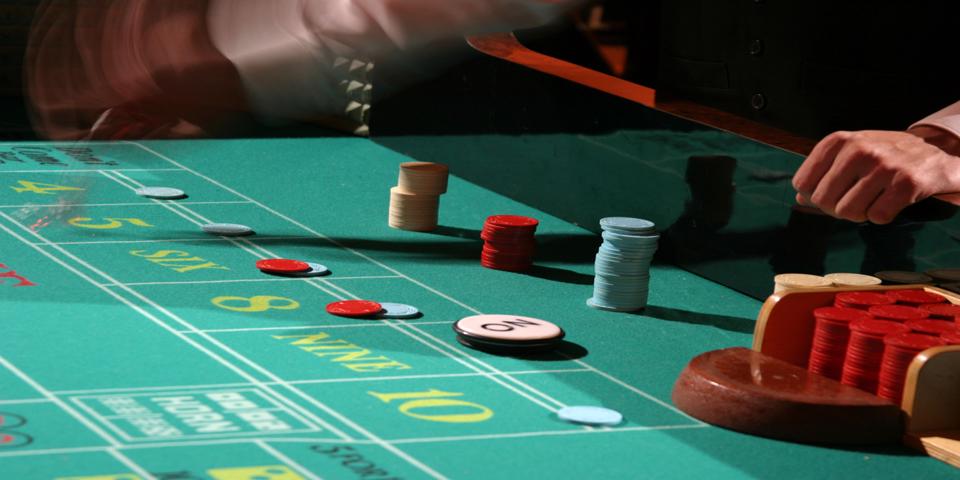
“don’t pass line” wagers bet against the shooter to win the shoot. They are also called “betting wrong.”
If the targeted shooter rolls a 2, 3, or 12 in the come out round, or fails to hit his/her point roll before “sevening out” in the point round, then the “don’t pass line” bettor doubles his/her money.
Come
A “come” bet is similar to a pass line bet and one of the more basic craps bets you can place. The player bets on “pass line” outcomes after the initial come out shoot has been made and the point value established.
If the shooter rolls a 7 or 11, the come bettor wins. If the player rolls something other than a 2, 3, 7, 11, or 12, that roll may become the “point” value for the come bet. Later shoots that hit the point value will double the come bettor’s money, even if the shooter does not win a pass line bet on that shoot.
Don’t come
Like don’t pass line bets, “don’t come” bets are the opposite of come bets. They bet that the shooter will lose the standards of a pass line win on a shoot taking place after the come out and the establishment of a point value.
Odds (“buy/lay”)
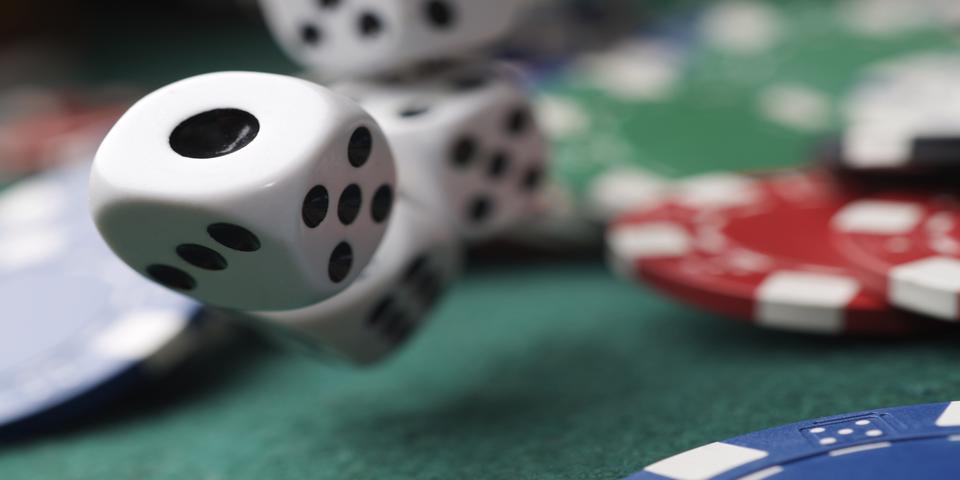
An “odds” bet is a side bet to the pass line or come bet. A player can “take odds” or “buy odds” when they’ve made a pass line or come bet; they can also “lay odds” when they’ve made a don’t pass line or don’t come bet.
Odds bets are typically limited to 2x-3x of the original bet. Payout depends on the likelihood of a particular roll—for example, 2/1 for points 4 and 10; 3/2 for points 2 and 9; 6/5 for points 6 and 8.
Place
A “place” bet is similar to an odds bet but does not offer “true odds” the way an odds bet does. As such, they usually pay out lower. A place bet can be made whether a pass line bet has been made or not.
Field
A “field” bet is a bet on the outcome of one particular roll of the dice. Less likely outcomes win, while the four most likely outcomes—5, 6, 7, and 8—lose.
A field bet on a roll pays out 1/1 for rolls 3, 4, 9, 10, and 11. It pays out 2/1 for a roll of 2, and 3/1 for a roll of 12.
Bix six or big eight
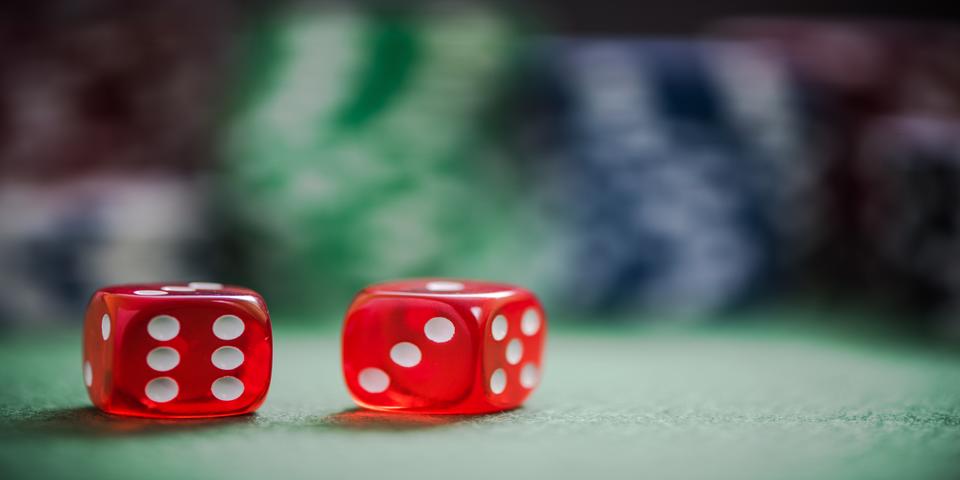
At any time, a player can place a bet that a 6 or an 8 will be the outcome of the roll. A “big 6” or “big 8” bet doubles the bettor’s money if the dice show the winning number to be 6 or 8.
Proposition
A player can make a “proposition” bet at any time, receiving a payout based on the likelihood of the outcome they bet on:
- “any craps.” if the shoot lands on 2, 3, or 12, the bettor reaps 12/1.
- “any seven.” if the shoot lands on 7, the bettor reaps 5/1.
- “eleven.” if the shoot lands on 11, the bettor reaps 16/1.
- “ace deuce.” if the shoot lands on 3, the bettor reaps 16/1.
- “horn bet.” if the shoot lands on 2, 3, 11, or 12, the bettor wins a return determined by the number shot.
Hop
Hop bets can be placed at any time. A player can wager on any dice outcome they like, down to the number on each die. Not all casinos or tables accept hop bets. Ask in advance, or check for signs indicating that hop bets are forbidden at the table you are playing at.
Hardways
Many combinations of two dice can result in an “8” shoot—2 and 6, 1 and 7, etc. These are called the “easy way.” A “hard 8”–the hardway of 8–is from a pair of dice, or 4 and 4. Players can bet on a shoot to land on a “hard 4,” “hard 6,” “hard 8,” or “hard 10” to bet on a matched pair of dice.
(“hard 2” and “hard 12” isn’t a thing, since a pair of 1’s and a pair of 6’s is the only way to produce this outcome.)
This long-odds proposition bet is also sometimes called the “sucker’s bet.”
How to win at craps
Anyone can get lucky with a big-winning long-odds bet on a single die roll like hardways or big 6/big 8, but it’s unlikely; these risky bets carry house edges over 10%.
Some gamblers swear that with practice, they can “control” the dice in the hand where they shake them and increase their ability to predict the outcome of the shoot. This is unproven and would take so much practice that the potential payout might not be worth your time. It also doesn’t apply to online craps.
Winning gamblers do not try to predict outcomes—they bet in such a way that maximizes the mathematical likelihood of them coming out ahead, while everyone else throws away their money and solidifies the house edge.
By picking a strategic system and sticking to it, you could lose a few shoots and still come out ahead. Just remember—the longer you play, the more the house edge reveals itself.
Some basic rules of thumb:
- Predicate your next bet based on your last bet, not on a “hunch.” bet lower if you’re losing, higher if you’re winning.
- If you want to enjoy a long session at the table without going broke (maybe even coming out ahead), stick to low-house-edge bets like pass line, don’t pass line, come, and don’t come.
- If you want a short session with a chance of a big payoff, indulge in some long-odds bets.
- Never bet more money than you are willing to lose.
Professional or experienced gamblers stack wagers to increase the likelihood of coming out ahead. Here’s an example of a craps wager stack:
Wager stack 1:
- Pass line bet
- Single or double odds on the pass line bet
- Come bet
- Single or double odds on the come bet
- When you win on one of the come bets, place another immediately.
The odds on various wagers are as follows:
Pass line bet
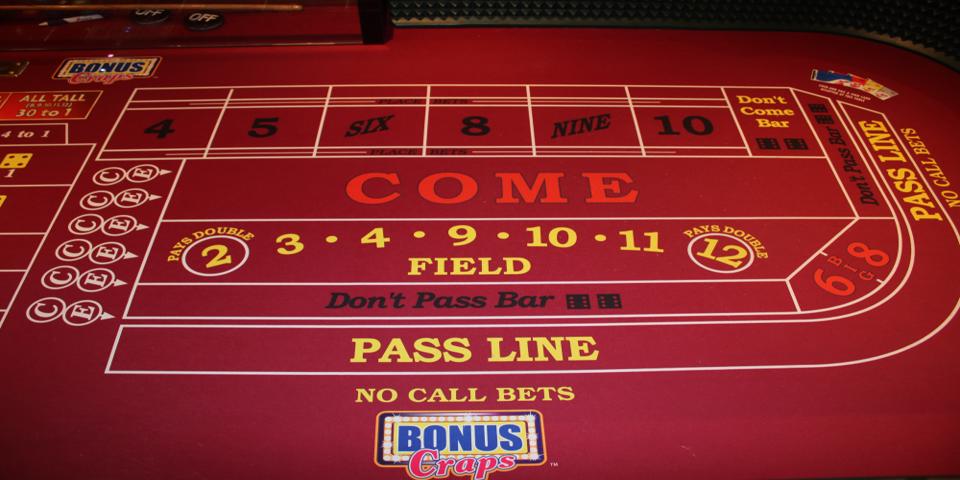
Odds: 251/244
House edge: 1.41%
Don’t pass line bet
Odds: 976/949
House edge: 1.36%
Come bet
Odds: 251/244
House edge: 1.41%
Don’t come bet
Odds: 976/949
House edge: 1.36%
Buying odds bet
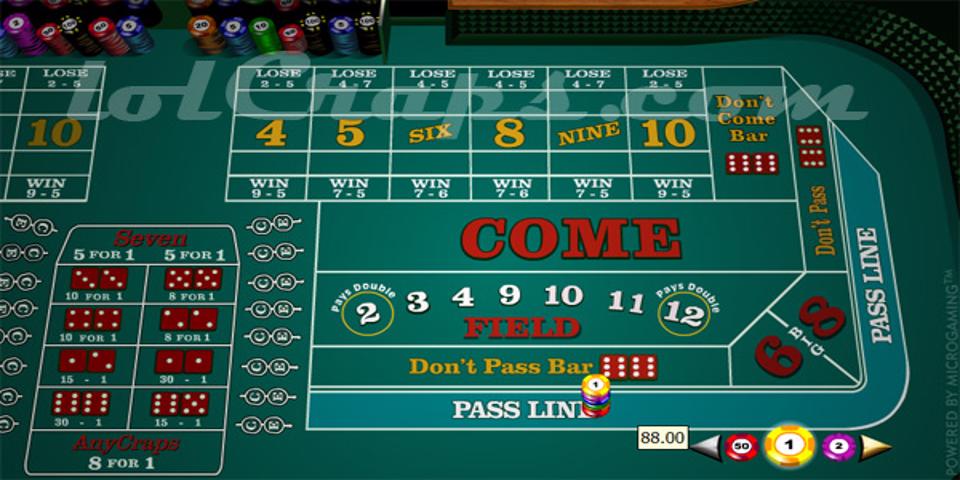
Payout: 2/1 on 4, 10; 3/2 on 5, 9; 6/5 on 6, 8
Odds: same as payout
House edge: 0%
Laying odds bet
Payout: 1/2 against 4, 10; 2/3 against 5, 9; 5/6 against 6, 8
Odds: same as payout
House edge: 0%
Field bet
Payout: 1/1, except 2 (2/1) and 12 (3/1)
House edge: 2.78%
Bix six or big eight bet
House edge: 9.09%
Proposition bet
Payout: varies (7/1 or more)
Odds: varies (8/1 or more)
House edge: over 10%
Hop bet
Payout: 15/1
House edge: 11.11%
Place bet
Payout: 6/5 on 6, 8; 3/2 on 5, 9; 2/1 on 4, 10
Odds: 7/6 on 6, 8; 7/5 on 5, 9; 9/5 on 4, 10
House edge: 1.52% on 6, 8; 4% on 5, 9; 6.67% on 4, 10
Hardways bet
Payout: 30/1 on 2, 12; 7/1 on 4, 10; 9/1 on 6, 8
Odds: 35/1 on 2, 12; 8/1 on 4, 10; 10/1 on 6, 8
House edge: 13.89% on 2, 12; 11.11% on 4, 10; 9.09% on 6, 8
Common questions and answers about craps
Question: can you play craps online for money?
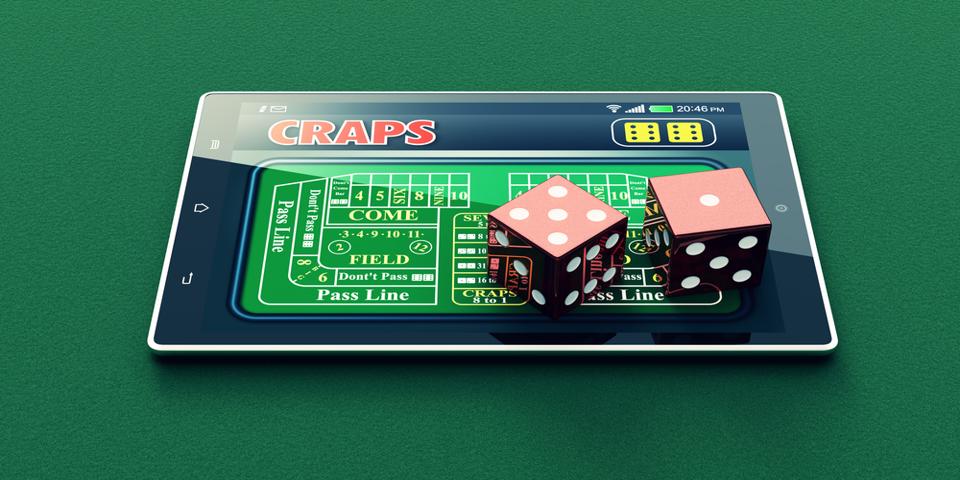
Yes, you can … but laws vary. A few states have expressly legalized online gambling and license online casinos. Other states have no specific laws prohibiting it, or they state that online gambling is illegal but set out no penalties for it (making it effectively legal).
Other states prescribe penalties of varying harshness for the crime of online gambling, though it’s unclear how strictly they’re enforced.
Regardless, online casinos will accept deposits by ACH, credit card, mobile wallet, wire transfer, or cash deposit at an affiliated casino, and do accept online wagers on digital craps games.
It is worth noting that state-licensed casinos must comply with oversight rules monitoring the fairness of the games, the protection of sensitive user data such as social security and credit card numbers, and the honoring of withdrawal requests.
The safest and fairest online craps games are probably those offered by the states that license online casinos, including:
States have different laws about whether you have to be physically located within the state (verified by GPS) or a resident of the state in order to gamble legally. You must also be of legal age to gamble in whatever locality you choose. Legal gambling ages vary by state and country.
Online craps games look like video-game versions of a craps table on a mobile or desktop browser. Animated dice may be thrown, but remember that the shoot result is determined by random-number-generating software, not the role of actual dice. In this digital environment, it is even easier for a casino to build in a predictable house edge.
However, state-monitored casinos must adhere to their house edge and not unfairly slant the game or make it unwinnable. This means that within the parameters of the house edge, it is perfectly possible for a player to get a lucky online shoot and win big money.
Question: what is the best bet in craps?
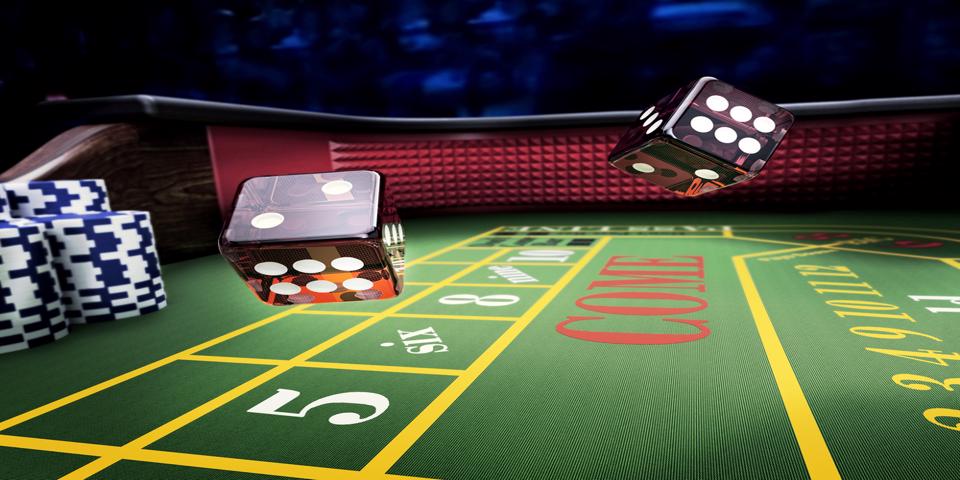
Everyone has to make a pass line bet to shoot craps at a casino, and this is actually a pretty good bet, with a house edge of only about 1.41%.
However, a better bet is a don’t pass line bet. With this bet, you are betting with the house, that another player is going to lose money. Don’t pass line bets still carry a house edge, but it’s down to 1.31%. Remember, though, to sit at the table and bet, you still have to make a pass line bet on your own shoots. You can’t just stand off in the corner and make don’t pass line bets on everyone else!
A pass line bet with odds has the lowest house edge in the game.
Hardways bets have the best payouts because they have the longest odds. Place bets are some of the most-likely-to-win bets, but their payout is small.
Again, craps players with longevity devise strategies that mathematically reduce their chances of losing money while increasing their chances of winning money.
An example wager stack was presented above. Here’s an example of another:
Wager stack #2:
- Once the point is determined, place two equal proposition wagers on 6 and 8 (the most likely outcomes).
- When one of the bets hits, come down one unit on each bet, extracting your winnings while leaving short-odds wagers on the table.
Question: how do craps odds work?
Calculating the odds of any particular roll of the dice coming up is fairly straightforward math. It behooves you to know how to do this before you play. The casino has definitely done the math!
The odds of any die roll coming up is calculated by ascertaining the number of possible ways the outcome could be generated, divided by 36 (6 sides on die 1 x 6 sides on die 2).
There are six ways two dice could land on 7. Six divided by 36 equals 1/6. Therefore, the odds of rolling a 7 at any given time would be 1/6.
Conversely, there’s only one way to roll a hard 10, so the odds of that outcome of a shoot would be 1/36.
The casino builds its “house edge” into the difference between the payout and the actual odds. This is why 1/36 odds pays out 35-to-one, whereas 1/6 odds pay out 5-to-one.
Question: how do you play video craps?
Some casinos offer video craps machines. These games are played in a similar fashion to online and mobile web craps games. You place your bet, with options including pass line, don’t pass line, come, don’t come, odds, and other popular craps bets.
You then press a button and random-number-generator software produces the shoot result, often with a pleasing “dice roll” animation.
Video craps machines in legal casinos can be used to play for money using chip, cash cage, or payment card deposits.
Question: how do you play the crap line in craps?
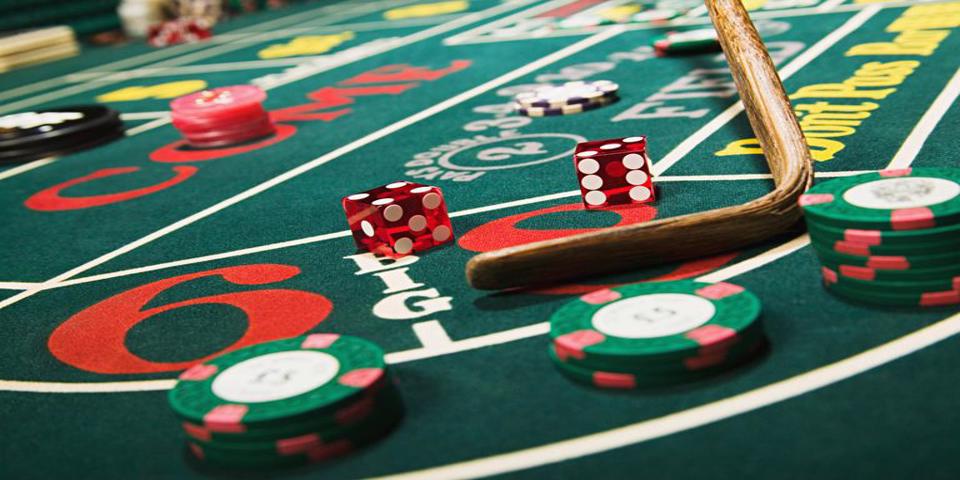
Before the come out round, place your desired bet on the pass line or don’t pass line section of the craps table.
Remember, when you play the pass line, you are betting on the shooter to win the shoot. A don’t pass line bet is a wager that the shooter will lose the shoot.
Question: how do you make an odds bet in craps?
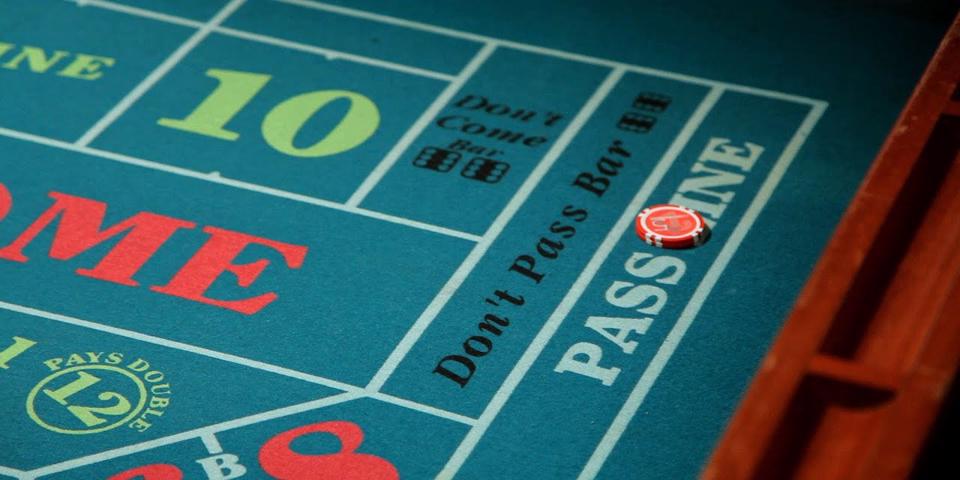
Once the point is thrown, odds bets can be placed on any line bet. Casinos usually allow you to bet:
- 3x the line bet on point 4 or 10
- 4x the line bet on point 5 or 9
- 5x the line bet on point 6 or 8.
Some casinos allow odds betting of 5x, 10x, 20x, or even 100x of the line bet on any point value.
Question: can casinos rig craps?

The main way to cheat at physical craps is to use loaded dice. Casinos could rig a craps table with loaded dice.
Since online and video craps determine the outcomes of their shoots with random-number-generating software, it would also be easy for them to skew the outcome in their favor.
However, casinos have no reason to rig either physical or digital craps games. Their profit is built into the house edge, not into the result of any one shoot.
Moreover, regulated casinos would lose their licenses if inspectors discovered a rigged craps game on the casino floor or an online casino app.
Summary
With colonial and potentially medieval roots, craps is one of the most low-tech and purest casino games of chance. You can’t fake or skew the odds on the outcome of a craps shoot—it’s literally a “roll of the dice.” in fact, “crapshoot” has entered the english lexicon as a synonym for an unpredictable outcome.
However, with many bets, side bets, and combinations of odds to choose from, meticulous and mathematically-inclined players have devised multi-step, stacked-bet strategies that can skew in their favor the odds of coming out ahead.
Alternatively, players looking for the thrill of a big win can plunk money they won’t miss on an unlikely outcome and join in the rowdy good fun. Either way, it’s more lively than a sedate blackjack or poker table.
Casino game craps rules
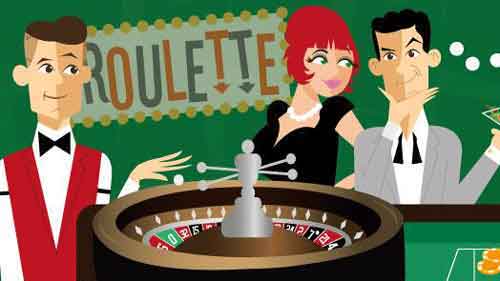
The 8 “best” roulette betting
systems
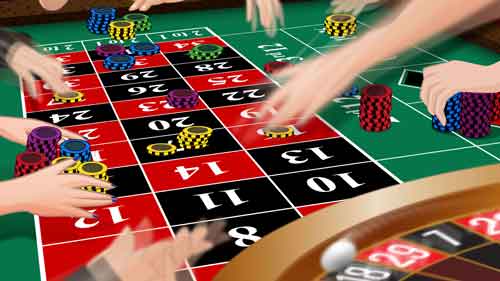
The big number trick at
roulette
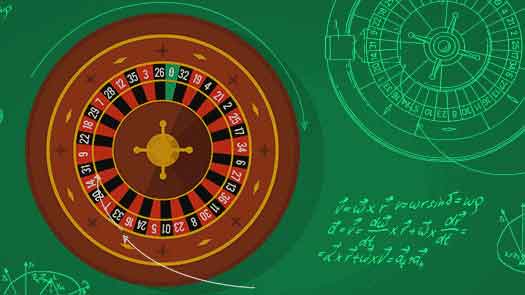
5 steps to beat roulette with
physics
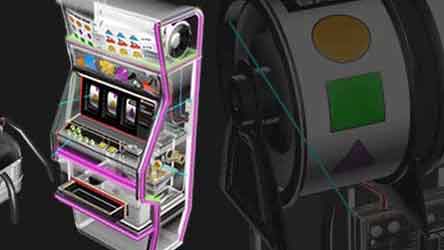
How a slot machine works?
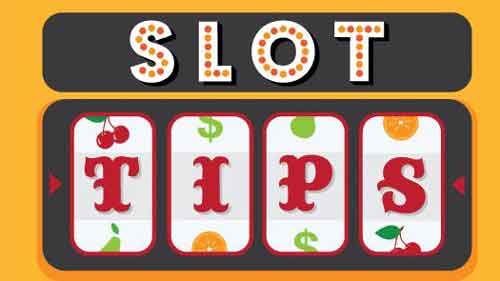
Slot tips: the do's & the don'ts
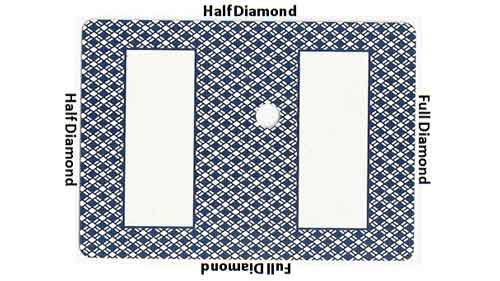
The future of edge sorting
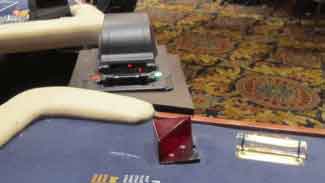
Hole carding, 101

Baccarat: the known card

Creating an online slot machine

Edward thorp: the man who
invented card counting

Don johnson: the man who has
beaten the casino

Gambling with james grosjean
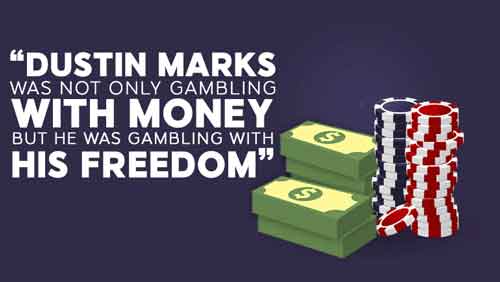
The best casino cheat in history?
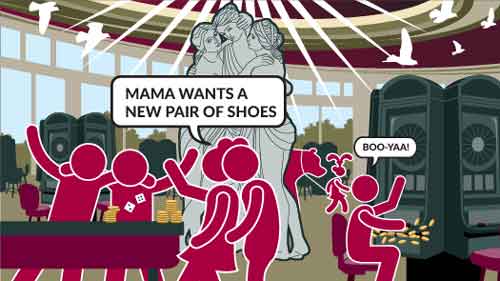
The secrets of casino design
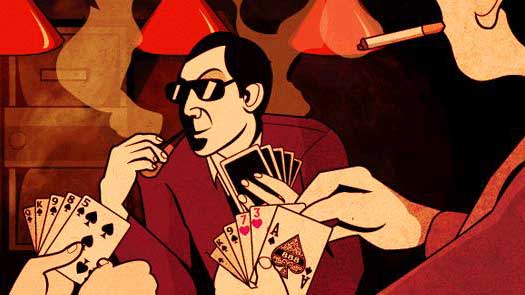
What happens in those
underground casinos?
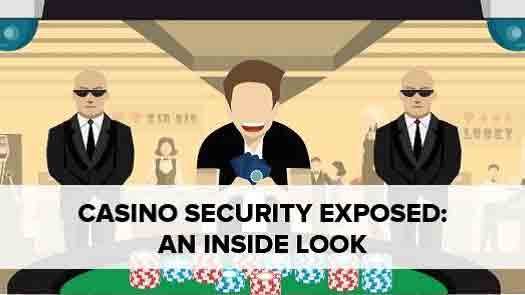
Casino security exposed: an
inside look
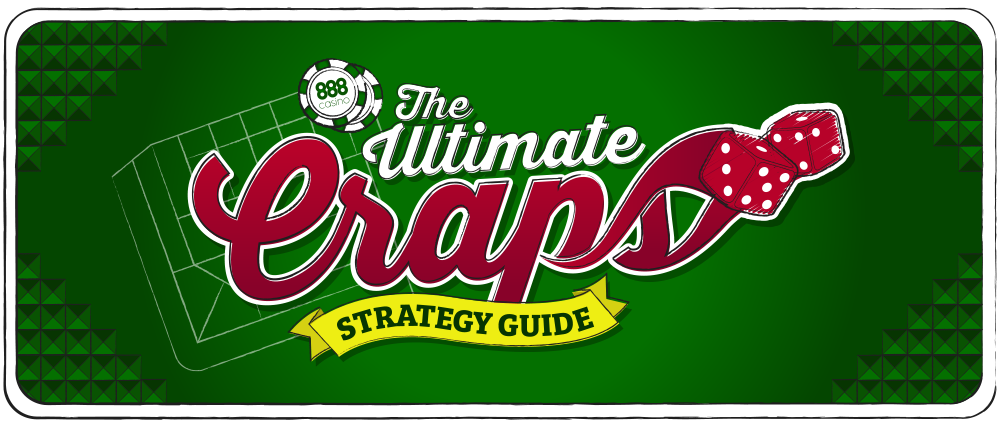
HOW TO PLAY CRAPS
THE BASIC RULES WHEN PLAYING CRAPS
- Craps has dozens of wagers available, but the game is structured around the pass line bet.
- Players bet by placing chips on the pass line on the craps layout. Some other bets require that the dealer move your chips.
- The pass sequence starts with a comeout roll and the shooter rolls the dice.
- Pass bettors win if the roll is 7 or 11 and lose if it is 2, 3 or 12. Any other number becomes the point.
- If the shooter rolls a point number on the comeout, he keeps rolling until either he rolls the same number again to win an even-money payoff, or rolls a 7 to lose.
- If the shooter makes his point, he keeps rolling with a new comeout. If he doesn’t, he “sevens out,” and the dice rotate to a new shooter
Craps can be as simple as betting on one number and either winning or losing on each roll, or as complex as making a bet, waiting until the shooter rolls a target, or “point” number, then hoping the shooter can roll the same number again. That procedure can go on for any number of rolls.
Let’s start with a look at the craps layout, then explain the available layouts.
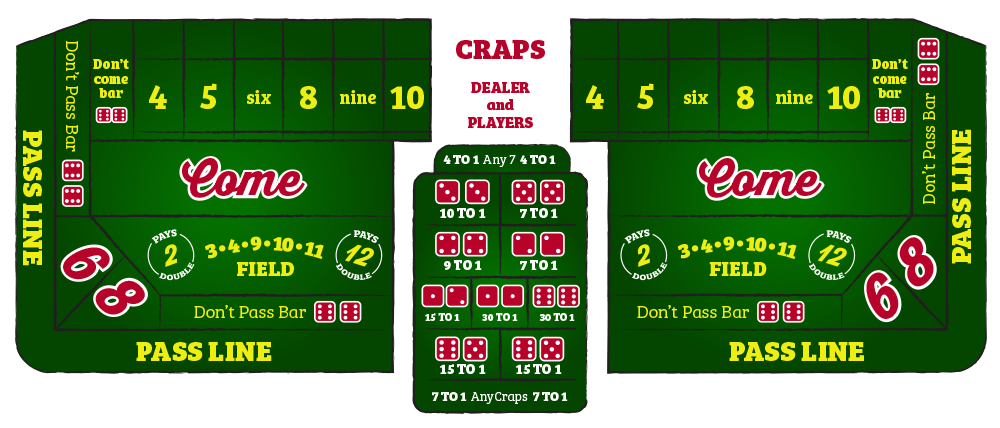
Each area of the craps layout signifies a different bet. If your chips are on the pass line, you’re making a pass bet, which is a multi-roll wager. If your chips are in the box that displays images of dice showing a 6 and a 5, you’re making the one-roll bet on 11. When you’re playing online craps, you can make any of the bets by clicking the layout on the screen. It’s different in live casino play. There, you can bet on pass, don’t pass, come, don’t come and the field by putting your own chips on the layout. For other bets, you put your chips directly in front of you on the layout and tell the dealer what you want. If you want to bet $5 on the place bet on 4, you would put $5 in chips in front of you, tell the dealer, “$5 place on 4,” and the dealer then would move your chips to the 4 box.
Let’s take a look at commonly available wagers and break that down into multi-roll and single-roll bets. You can have more than one bet in action at once – in fact most craps players have several bets working at a time. Not every possible wager is listed, though house edges for wagers such as lay bets – betting on 7 to come up before a place number – and horn bets are listed in the chart in the final chapter.

HOW TO PLAY MULTI-ROLL BETS
PASS
House edge: 1.41%
Winning bets are paid even money, but when non-craps players say the game confuses them, this is usually the bet they have trouble following. It usually takes more than one roll to decide, and while 7 starts out being a good roll for players it ends up being a losing number.
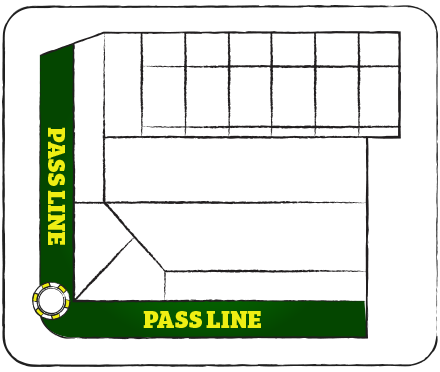
But really, it’s not all that complicated. Casinos aren’t in the business of making rules so intimidating they chase potential players away from the tables. If we don’t play, the operators can’t make money.
The pass line sequence starts with a “comeout roll.” you can tell if the next roll is a comeout by the placing of a disc on the table. If the disc is toward a corner of the layout and is turned so the face-up side is black with the word “off,” then the next roll is a comeout. If the disc is in a numbered box and has a white side saying “on” face up, then the pass sequence already is underway and the next roll is not a comeout.
On the comeout, if the shooter rolls a 7 or 11, pass bets win. If the shooter rolls 2, 3 or 12, pass bets lose. If the shooter rolls 4, 5, 6, 8, 9 or 10, that number becomes the point and the object of the game changes. Now the shooter must roll that number again before rolling a 7.
No other rolls matter in deciding the pass bet. If the point is 6 and the next several rolls are 4, 8, 3, 11, 5, 12, for example, the pass bet just stays in action. The bet isn’t decide until the shooter either rolls the point again or rolls a 7.
COME
Come is the same bet as pass, except you make it when there already is a point for pass bettors. If the next roll is a comeout, then the bet you want is pass. If there already is a point, then you can bet come and the next roll is treated as a sequence starter for your come bet.
Let’s say that on the comeout the shooter rolls a 6, and that becomes the point. Before the next roll, you bet on come. Then if the shooter rolls a 7 or 11, your come bet wins, if he rolls 2, 3 or 12 the come bet loses and any other number becomes a point for your come bet.
Note that the same 7 that wins on your come bet could lose on the pass line, and a 2, 3 or 12 that loses on come will have no effect on pass. Say 6 is established as a point on craps and you follow with a come bet. If the next roll is 7, you win on come but lose on pass. If it’s 11, you win on come and your pass bet stays in action, and if it’s 2, 3 or 12 you lose on come and your pass be stays in action.
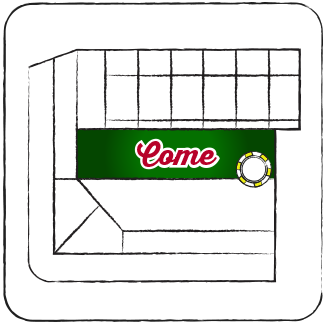
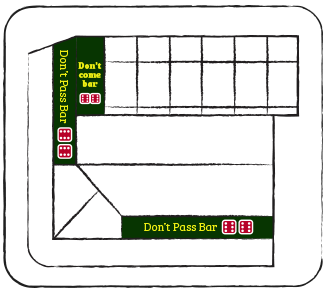
DON’T PASS AND DON’T COME
These are the near opposites of pass and come. Like them, you bet don’t pass if the next roll is a comeout and don’t come if it isn’t.
On the comeout for a don’t pass bet or on the first roll after making a don’t come bet, you win if the roll is 2 or 3 and lose if the roll is 7 or 11. You don’t win if the roll is 12 even though 12 is a loser at the start of pass or come sequences. Instead, the bet is a push and you can take your money back after a 12. If the roll is any other number, it becomes the point. If a 7 rolls before the point is repeated, don’t bettors win, and if the point comes first, they lose – the opposite of pass or come.
Most players prefer playing the pass side so they are rooting for the shooter and have the camaraderie of winning together. They refer to don’t players as “wrong bettors” and “the dark side.” but the house edge is slightly lower on the don’ts and the dark side has its followers.
FREE ODDS / LAY ODDS
House edge: 0%
Winning bets are paid at true odds, varying according to point number. It’s rare that you get an even break on casinos games, but the odds give you just that. They’re called “free odds,” but it’s not a free bet – you still have to but money at risk. The “free” just signifies that there is no commission or other method of making this bet profitable for the house.
In order to take free odds, you must first make a pass or come bet. After a point is established, you may back your pass or come bet with a second wager. Originally, that free odds bet had to be equal to your pass or come bet, but today most casinos allow you to bet multiples of your original bet.
The great part is that the free odds are paid at true odds. If the point number is 6 or 8, a winning free odds bet is paid at 6-5 odds. Payoffs are 3-2 on points of 5 or 9 and 3-1 on 4 or 10.
Those reflect the actual odds of rolling those numbers. Using two six-sided dice, there are 36 possible combinations. Six of them total 7, with there are five each if 6 and 8, four each of 5 and 9 and three each of 4 and 10.
Six ways to roll 7 and 5 ways to roll 6 means the true odds against rolling 6 before 7 are 6-5, exactly the same as the payoff on winners. Hence, no house edge. It works the same way on all the point numbers. Payoffs are the same as the odds against winning the bet. There is no house edge on the odds themselves, though the house retains its edge on the pass or come bet you must make before betting the odds.
If a casino offers single odds, then your odds bet must be equal to your pass or come bet. If the casino offers multiple odds, then your odds bet may be any multiple of the original up to the maximum. When 10x odds are offered for example, your odds bet may be 1, 2, 3, 4, 5, 6, 7, 8, 9 or 10 times your original bet.
Many casinos today offer 3, 4x, 5x odds meaning you may make an odds bet of three times your original wager if the point is 4 or 10, four times if the point is 5 or 9 or five times if the point is 6 or 8. This makes calculating payoffs easy – with maximum odds, total payoffs are the same on any point. If you bet $5 on pass, then a $15 odds bet on 4 or 10 pays 2-1, or $30; a $20 odds bet on 5 or 9 pays 3-2, or $30; and a $25 odds bet on 6 or 8 pays 6-5, or $30.
Don’t pass and don’t come bettors can lay the odds instead. To use a point number of 6 as an example, once that point is established, the don’t bettor has six ways to win – the six possible ways to make 7 – and only five ways to lose – the five ways to make 6. When you lay the odds, you win $5 for every $6 you bet on 6 or 8, $2 for every $3 you bet if the point is 5 or 9, and $1 for every $2 you bet when the point is 4 or 10.
The payoffs reflect the true odds, just as when a pass/come bettor takes free odds. There is no house edge on the lay odds, but the house has an overall edge because you must bet don’t pass or don’t come first.
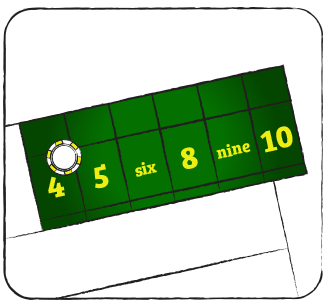
PLACE BETS
Winning bets are paid at 7-6 odds if you’re betting on 6 or 8, 7-5 on 5 or 9 and 9-5 on 4 or 10. Want to choose your number without waiting for the shooter to establish a point on the comeout? Place bets enable you to do just that. When you make a place bet, you’re betting the shooter will roll your number before he rolls a 7. As on pass, no other numbers matter. If you place 6 and the next several rolls are 5, 4, 12, 3, 9, 8, then there is no decision on your bet. You win only if the shooter rolls your number, and lose if he rolls 7. These pay more than even money, but less than true odds. Instead of the 6-5 true odds of making a 6 or 8, those numbers pay 7-6, giving the house it’s 1.52% edge.
One important point: if you place 6 or 8, be sure to bet in multiples of $6 so the house can make that 7-6 payoff. If you bet $5 instead, the house will pay at even money.
Many players like to place 6 and 8, the most frequently rolled winning numbers. Other place numbers, with higher house edges, are less popular.
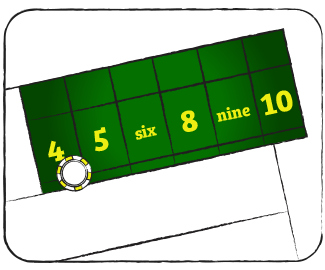
BUY BETS
Winning bets are paid at true odds, but you have to pay the house a 5% commission to get that deal. For example, if you buy the 4 for $20, you must also pay the house a $1 commission. Then if you win, you’re paid at the 2-1 true odds. That lowers the house edge from 6.67% to 4.67% on 4 or 10, but raises the house edge on other numbers.
However, some casinos charge the commission only if you win. That drops the house edge to 2% if you buy 5 or 9 and 1.67% on 4 or 10, making buying a better option than placing. The house edge on buying 6 and 8 under these conditions is 2.27%, so you’re still better off with the 1.52% for a place bet.
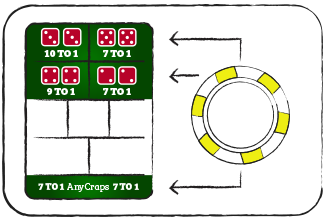
HARDWAYS
Payoffs are 9-1 on 6 or 8 and 7-1 on 4 or 10. A number rolled the hard way means that both dice show the same number. A hard 4 is a 2 on each die. Hard 6 is 3 on each die, and so on. To win a hardway bet, your number must come up the hard way before the shooter rolls either the 7 or your number any other way. If you bet hard 8 and the roll is 2-6 or 3-5, you lose. Only 4-4 is a winner.

HOW TO PLAY ONE-ROLL BETS
Before getting into the individual bets, the payoffs listed below are the most common. A one-roll bet on 2 usually pays 30-1, but some casinos, especially in the united kingdom and australia, pay 31-1, 32-1 or, rarely, 33-1. The higher the payoff, the lower the house edge.
Also, the listings are odds-to-1. Some casinos pay odds-for-1, which essentially means your bet is included in the payoff. If you bet $1 and are paid 30-to-1, you keep your $1 bet and get $30 in winnings. If you’re paid 30-for-1, $29 in winnings are added to your $1 to give you a total of $30. Beware tables that pay odds-for-1.
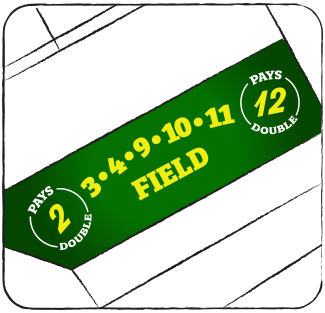
THE FIELD
Winners are paid even money most of the time, but are paid 2-1 if the roll is 2 and either 2-1 or 3-1 if the roll is 12. Some casinos, especially in reno, nevada, reverse that and pay 3-1 on 2 and 2-1 on 12. If both 2 and 12 pay 2-1, the house edge is 5.56%. If either pays 3-1, that cuts the edge in half to 2.78%.
2 OR 12
Winners are paid 30-1. If you bet on 2 the next roll must be 2. If you bet on 12, the next roll must be 12. All other numbers lose.
3 OR 11
House edge 11.11%
Winners are paid 15-1. If you bet on 3 the next roll must be 3, and if you bet on 11, the next roll must be 11. All other rolls lose.
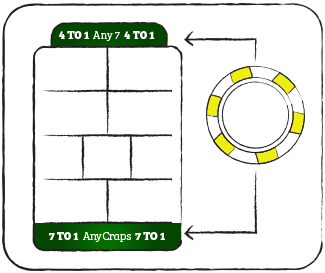
ANY 7
ANY CRAPS
You get three numbers on this bet – you win if the next roll is 2, 3 or 12.
HOP BETS
Winners are paid 30-1 on hard hop bets and 15-1 on easy hop bets.
On hop bet, you’re betting each die will land on a specific number. You tell the dealer,”6-3 hopping” or “4-2 on the hop,” and you win only if the dice show those specific numbers.
On a “hard hop,” both numbers are the same, such as 1-1 or 4-4. When the two numbers are different, the bet is an “easy hop.”
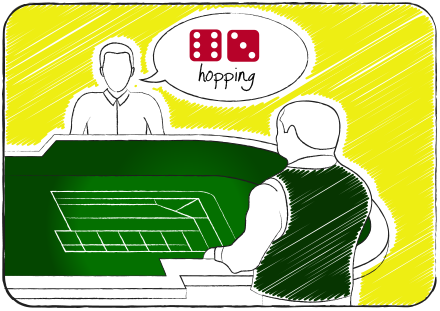

CRAPS RULES
Craps is the same game online and in live casinos, but some rules and procedures are a little different. Here are a few point every player should know before playing.
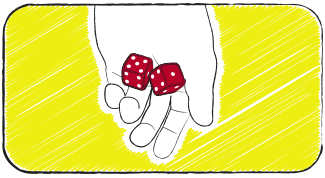
RULE #1: NUMBER OF DICE
Two six-sided dice are used, and you are betting on the total of the numbers that land face up on both dice.
If one die lands on 2 and the other on 4, then the number on that roll is 6. If the numbers are 1 and 1, then the roll is 2.
You cannot bet on each die separately. There is no wager that one die will show no. 1, for example. All craps bets are on two-dice totals.
RULE #2: BUYING CREDITS
At online casinos, as in other games, you start by making a deposit, or if you already have funds on deposit, you may draw on them for money to play.
At live casinos, most players buy in at the table. Some already have chips from previous play and some who have credit accounts at the casino may have chips from having cashed a credit marker.
But most pay as they play. You do so by putting cash on the layout and telling the dealer you want to buy chips. The dealer is not permitted to take cash directly out of you hand. You must put your cash on the table and the dealer then will take it and give you chips.
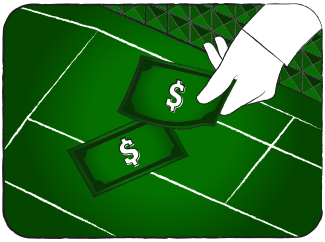
RULE #3: TABLE PERSONNEL
Online, all decisions and payouts are done automatically, but in live casinos there’s a human crew. The common complement is four people: the boxman, the stickman and two dealers.
The boxman is in charge of the table, watching to make sure players follow rules and that dealers make proper payoffs. When you buy in by putting cash on the table, a dealer gives the cash to the boxman, who lays it flat, face down on the table, then watches as the dealer gives you chips. When the transaction in complete, the boxman then uses a flat plastic paddle to push the cash into a drop box, which later will be taken by guards for transport to the count room.
The stickman holds a long hooked stick, which he uses to push dice around the table. When it’s your turn to shoot, the stickman pushes the dice to you. He also handles the proposition bets at the center of the table.
The dealers each are in charge of one end of the table, giving you chips when you buy in, moving your wagers to the appropriate spots on their ends of the table and making payoffs.
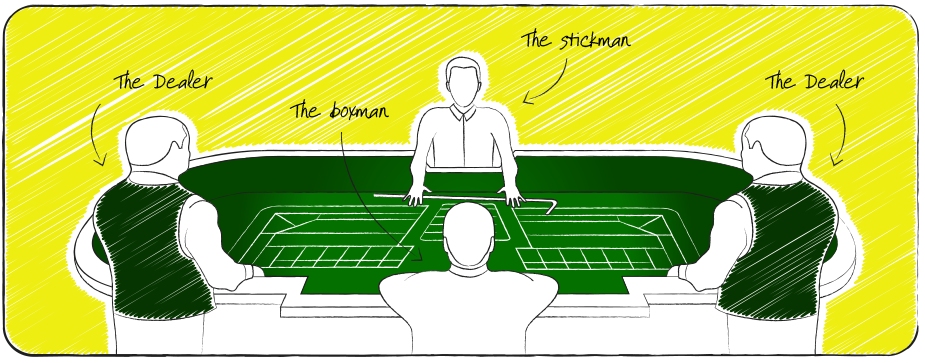
RULE #4: BETTING
At most online casinos, your screen will include a graphic of the craps layout. You may click on chip images to determine how much you want to bet, then again on the screen to place the chips on the bet you want. If you want to make the bet labeled “pass line,” you would click on the pass line area. If you want to bet on 11, you would click on a box depicting 11 with images of one die on 6 and one on 5.
At live casinos, you may place your own chips on the pass line and in areas marked “come” and “field,” but for must bets, your chips must be placed by the dealer. You push chips in front of you on the layout and tell the dealer, “$6 each on 6 and 8.” the dealer then moves your chips to the appropriate box and positions it in accordance to your position at the table, so he knows both what the bet is and who made it.
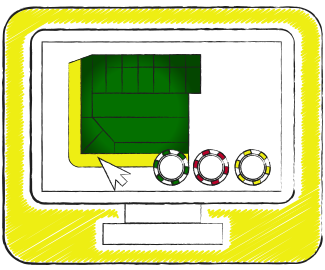
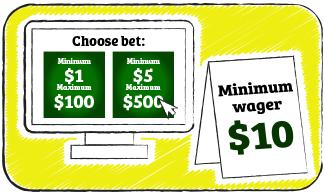
RULE #5: BETTING LIMITS
Online, you’ll usually be asked to choose from a range of minimum and maximum bets. For example, you might be presented with options of minimum bet $1, maximum $100; minimum $5, maximum $500; or minimum $10, maximum $1,000. You choose the range that’s within your comfort zone. In live casinos, there will be a placard on the table detailing minimum and maximum bets. If the placard lists a minimum wager of $10 and you only want to put $5 on the line, then you need to look around and see if there’s another table that’s more friendly to your bankroll.
RULE #6: THE SHOOTER
At online casinos, virtual dice are rolled and results determined by a random number generator. In live casinos, shooters take turns. To see how that works, we need to revisit the pass line.
You’ll remember from chapter 2, the pass line sequence starts with a comeout roll. If the shooter rolls 7 or 11, pass bets win, and if he rolls 2, 3 or 12, pass bets lose. Any other number becomes the point. If the shooter rolls the point number again before 7, pass bets win, but if a 7 comes first, pass bets lose.
When the shooter rolls a loser 7 after establishing a point, he’s said to “seven out.” at that point, the dice rotate to a new shooter. Not all losing rolls bring a new shooter. If pass loses with a 2, 3 or 12 on the comeout, the shooter has not sevened out and keeps shooting.
Similarly, not all 7s are seven out. If the shooter makes a point, the sequence starts all over with a new comeout, and on that comeout 7 and 11 again are winners.
As long as the shooter keeps making points and avoids seven out, he keeps shooting. In the longest streak on record, patricia demauro rolled 154 times without sevening out in 2009 at the borgata in atlantic city. That streak took four hours, 18 minutes before the dice passed to the next shooter.
Craps
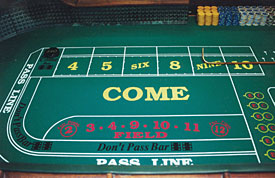
What have we learned is the first thing to do when playing a casino table game? Place a bet. With craps, the only player who must place a bet prior to the first roll of the game is the shooter (or person who wants to roll the dice). To become eligible to become a shooter, place a bet on the pass line or don't pass bar. The dice are passed to players in a clockwise direction so you might have to wait a while for your turn as a shooter. If you want to play, but don't want to be a shooter, you also may place this bet, but are not required to do so and may wait to place a bet after the come out roll. The stickman (the guy with the stick who assists the dealers) will push about five dice toward you. With only one hand, pick up two. Next, roll the dice hard enough so that they hit the wall of the opposite end of the table. The object of this come out roll is to establish a point, which needs to be something other than a 2, 3, 7, 11 or 12.
On the come out roll, if a 7 or 11 is rolled prior to establishing a point, any player who bet on the pass line wins. If, however, a 2, 3 or 12 is rolled, the pass line bet loses. The opposite is true with the don't pass bet, in which case, the 7 and 11 loses, and the 2, 3 and 12 wins, if rolled prior to a point being established.
Once you have established a point, which will be a 4, 5, 6, 8, 9 or 10, the dealer places a plastic disc (white side up) on the corresponding box on the craps table. At this time, all players are either betting that you will either roll that point again before you roll a 7 or vice versa.
Example - your come out roll is a 4. Players who had placed a wager on the pass line will leave their wager and will win if you roll another 4 before you roll a 7. However, players who initially placed a wager on the don't pass bar will win if you roll a 7 before you roll a 4.
Any players who didn't place a wager prior to the come out roll, either by choice or because they showed up at the table afterward, are no longer eligible to place a pass line or don't pass bet. Instead, they may place a come or don't come bet.
If a player places a come bet, the rules of the initial pass line apply. If the next roll is a 7 or 11, the player wins. If the next roll is a 2, 3 or 12, he loses. However, if a 4,5,6,8,9, or 10 is rolled, that will be the point for that player, which could be different than the point for the original players. Once the point is established for the new player, he is betting that his point will be rolled before a 7.
If a player places a don't come bet, the rules of the don't pass bet apply with one exception. If the next roll is a 7 or 11, the player loses. If the next roll is a 2 or 3, the player wins. The exception is that if the shooter rolls a 12, the bet on the don't come is a tie. Any other roll becomes the point for that player who is betting that a 7 will be rolled before that point.
As stated before, these are the absolute basic bets for craps, which is enough to get you in the game. Our best advice is to observe the habits of other more experienced players, particularly the ones winning!
Craps basic rules
The game of craps is said to have the best odds for the player of any other casino game, with a house edge as low as 0.02% if you know how to make the right bets. In this section we will teach you about the rules of craps and give some tips about how to make those good bets.
The table that craps is played on is oblong in shape and has many areas for placing wagers. The sides of the table are high in order to keep the single pair of dice inside of it as well as possible, only one pair of normal six sided dice are used, so when the dice are rolled, the values possible range from 2 through 12.
Craps can be a very involved game and there are many types of bets that you can learn, but here we will focus on the best of them in an attempt to get the new player off to a good start. Basic craps rules involve someone rolling a pair of dice while other players around the craps table make bets either with or against the shooter. Each player takes a turn with the dice, or being the shooter.
The first basic bet to understand in craps rules is the pass line bet. The pass line bet is made by a player placing their chips on the area of the table marked “pass line”. Conversely, don’t pass bets are betting against the shooter. The pass line bet is known as a series bet because the shooter may have to roll the dice more than once before that wager is won or lost. The first roll in a series is called the come-out roll and it is treated differently than other rolls.

On the come-out roll a 7 or 11 are automatic wins for a pass line bet and the series ends there. If a 2, 3, or 12 (also known as craps) are rolled these are automatic pass line losers and the series also would end there. Any other number (4,5,6,8,9,10) becomes the shooter’s ‘point’ and the series will continue.
The point becomes the goal of the shooter going forward in the series. The shooter is now trying to roll the same number again before rolling a 7. If the shooter rolls a 7 before rolling their point again this is known as ‘seven out’; pass line bets lose, the series ends, and the dice move to the next shooter for a new series. If the point is rolled before a 7, pass line bets win, and the series ends. If any number besides the 7 or the point is rolled, nothing happens and the shooter continues to roll.
Note: pass line bets are only made at the beginning of a series. Once point is made, other wagers can be placed but not on the pass line. We will review some of the other more common wagering options below.
The odds bet
When a player has made a pass line bet and point has been established, there is another wagering option available known as the odds bet. Odds bets can be placed in addition to your pass line bet and they are considered a better wager because the house does not take a cut of the payout. For this reason it is often referred to as “free odds” and is also considered a smart wager to make once point has been established. This bet is made by placing chips directly behind your pass line bet after point has been made. Some casinos offer double odds on these wagers, meaning that you can place up to twice the amount of your pass line bet. The payout on an odds bet is typically 3 to 2, so it is recommended to bet in even numbered dollars when point is 5 or 9.
Come bets
Come bets are similar in nature to pass line bets, but these bets are made only after point has been established rather than before. When you make a come bet, if the next roll is a 7 or 11 you win, but if the next roll is a 2,3, or 12 you lose. If any other number is rolled (4,5,6,8,9,10) this becomes your come point. The dealer moves your bet to the number on the table layout that corresponds to your come point.
If you have both a pass line bet and come bet in the same series, you have two points working in your favor (yours and the shooter’s), so if either of these numbers comes up before a seven, you win.
Don’t come bets
Don’t come bets are the opposite of come bets, similar to how don’t pass are opposite of pass line. In a don’t come bet, a first roll of 2 or 3 wins, and 12 is a standoff.
Place bets
Place bets can be made on the numbers 4,5,6,8,9, and 10. If you place a wager on one of these numbers after point is made and that number comes up before a 7, you win. The payoff on this wager is typically 9 to 5 on 4 and 10, 7 to 5 on 5 and 9, and 7 to 6 on 8 and 6.
These are some of the more common wagering tactics in the rules of craps in most casinos both in person and online. If you are a new player to the game of craps, learning craps rules online may be a good option because you will not have to worry about holding up the game by taking your time to study the table or to determine what wager you would like to make as you learn the game. Many new players find this a great way to learn the game in the comfort of their homes in a more relaxed environment.
So, let's see, what we have: learn about the casino game of craps, including basic game rules, betting strategy, and bet payouts. At casino game craps rules

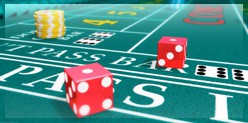

No comments:
Post a Comment